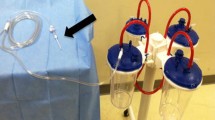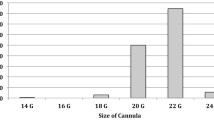Abstract
Purpose
The purpose of our study was to assess if plastic containers could decrease the overall procedure time for paracentesis relative to more commonly used glass containers.
Methods
In this IRB exempt study, initial pilot data comparing filling time of glass and plastic containers in an ex vivo setting under identical conditions revealed power calculations that n = 37 patients per group would be needed to achieve standard deviation (SD) = 60 s, difference (diff) = 40 s, two-tailed alpha-level 0.05, and power 80%. Total of 43 patients (93 containers) were enrolled and randomized to glass or plastic bottles at enrollment. Timing of bottle filling was assessed using standardized sonographic screen captures.
Results
An interim look at statistics at n = 20 patients indicated that original conjectures from pilot data were conservative and smaller sample size was sufficient to stop the study and conduct the analyses. Specifically, SD = 54 s, diff = 49 s, two-tailed alpha-level 0.05, and power 80% required n = 21 patients per group. Plastic containers had a statistically significantly lower average filling time per bottle (162.7 ± 53.3 s) compared to glass (212.2 ± 50.4 s) (p = 0.003). Viscosity was calculated for each specimen and did not affect the statistical significance of the results (p = 0.32).
Conclusion
Plastic containers have 50 s time savings of per bottle filling time as compared to glass bottles as theorized based on their faster flow rate. This holds true in both an ex vivo setting and in patients and can have important downstream impacts on patient throughput, provider efficiency and system wide cost savings.
Similar content being viewed by others
References
Thomsen TW, Shaffer RW, White B, Setnik GS (2006) Videos in clinical medicine. Paracentesis. N Engl J Med 355 (19):e21. https://doi.org/10.1056/NEJMvcm062234
Neong SF, Adebayo D, Wong F (2019) An update on the pathogenesis and clinical management of cirrhosis with refractory ascites. Expert Rev Gastroenterol Hepatol 13 (4):293-305. https://doi.org/10.1080/17474124.2018.1555469
Sanyal AJ, Bajaj JS, Shaw J (2010) Paracentesis. In: Ascites, Hyponatremia and Hepatorenal Syndrome: Progress in Treatment. In: Gerbes AL (ed) Front Gastrointest Res, vol 28. Karger, Basel, pp 23-31
Duszak R, Jr., Chatterjee AR, Schneider DA (2010) National fluid shifts: fifteen-year trends in paracentesis and thoracentesis procedures. J Am Coll Radiol 7 (11):859-864. https://doi.org/10.1016/j.jacr.2010.04.013
Frosch R, Gallopoulos N (1989) Strategies for Manufacturing. Scientific American 261 (3):144-153
Acknowledgments
The authors gratefully acknowledge the contributions to this study of Ms. Tyrica Myers as well as the sonographers, faculty, residents, fellows and staff in our Interventional Ultrasound suite. We also wanted to thank the members of our Procurement and Supply Chain Management team for their assistance in the financial analysis used in this work.
Author information
Authors and Affiliations
Corresponding author
Ethics declarations
Conflict of interest
None
Additional information
Publisher's Note
Springer Nature remains neutral with regard to jurisdictional claims in published maps and institutional affiliations.
This project was performed at the Department of Radiology at Duke University Medical Center. There is no other internal or external funding for this project. This manuscript is not under consideration elsewhere. This is a HIPAA compliant, IRB-exempt study with waiver of informed consent granted by the local institutional review board.
Rights and permissions
About this article
Cite this article
Perry, W.P., Barrett, J.J., Secic, M. et al. Can procedure time for paracentesis be optimized based on bottle selection?. Abdom Radiol 46, 4062–4067 (2021). https://doi.org/10.1007/s00261-021-03033-8
Received:
Revised:
Accepted:
Published:
Issue Date:
DOI: https://doi.org/10.1007/s00261-021-03033-8




